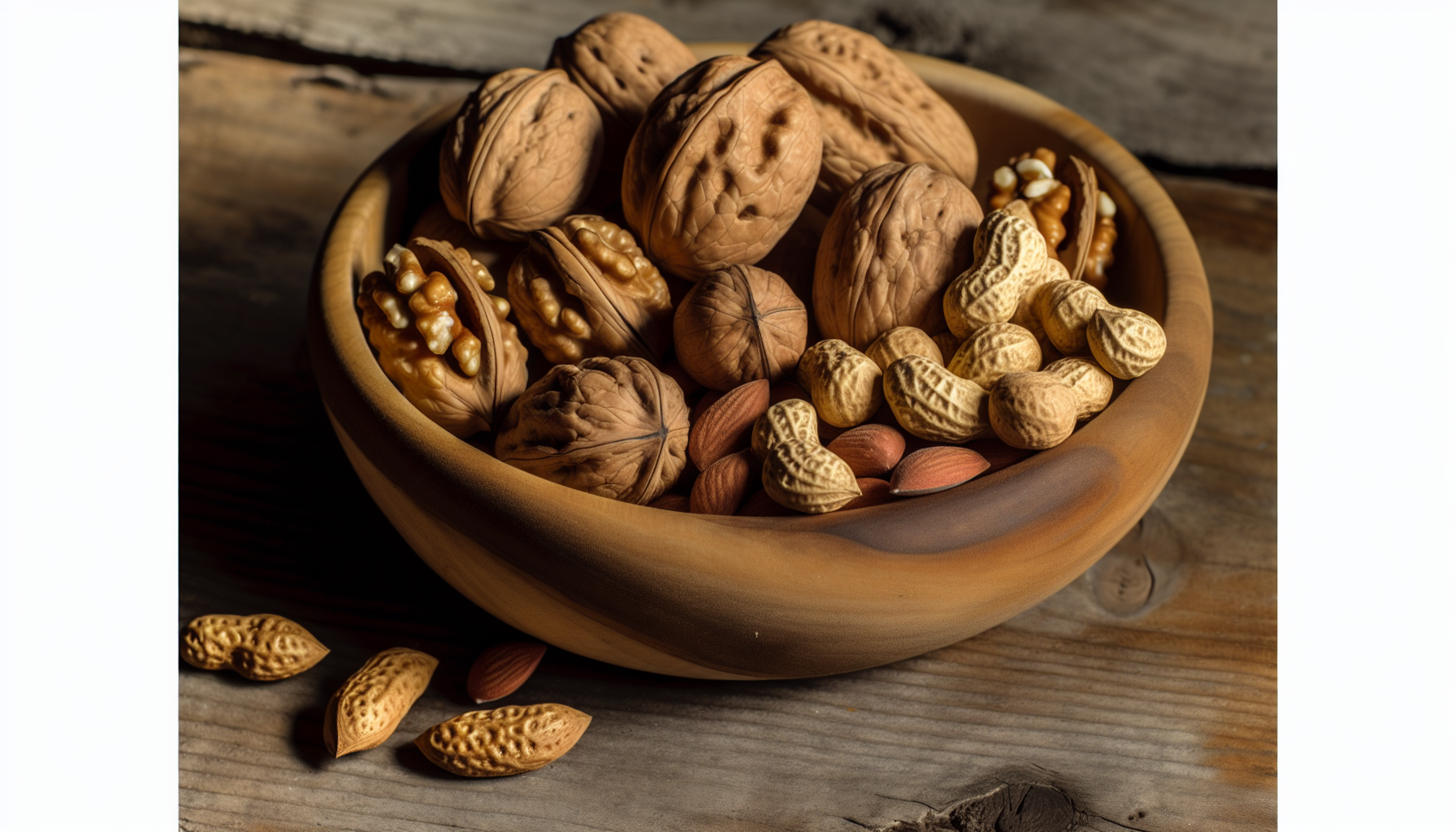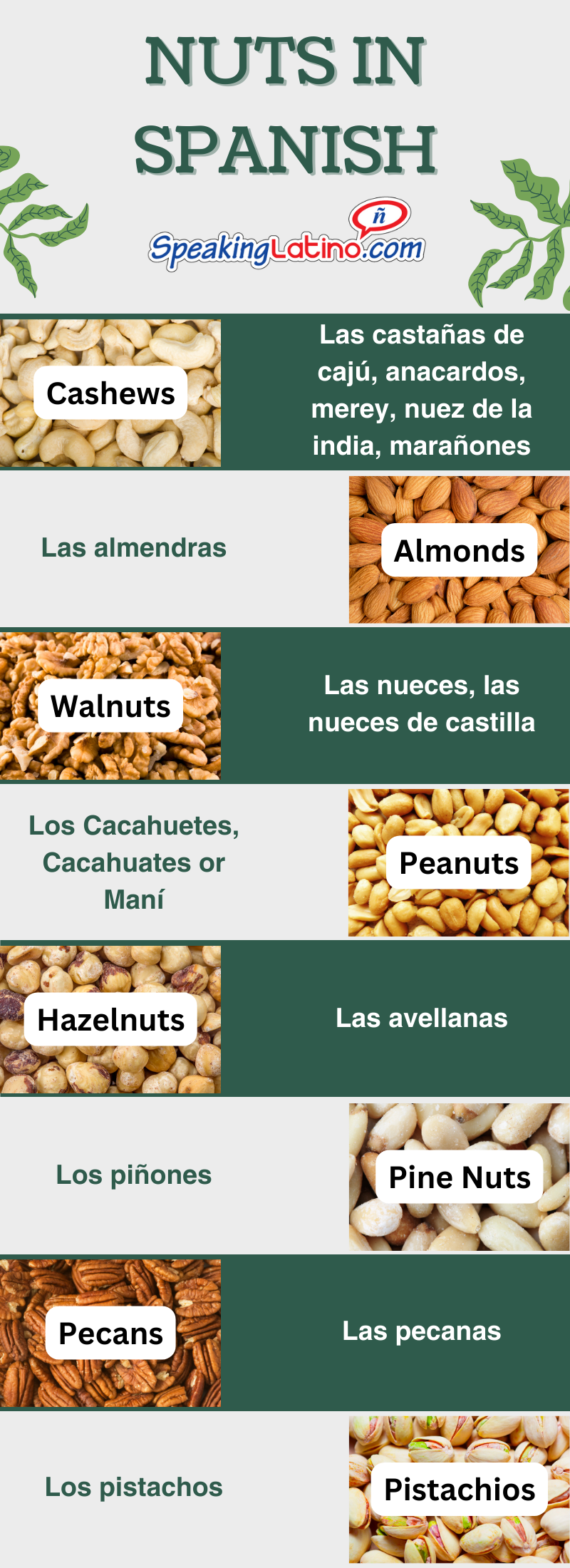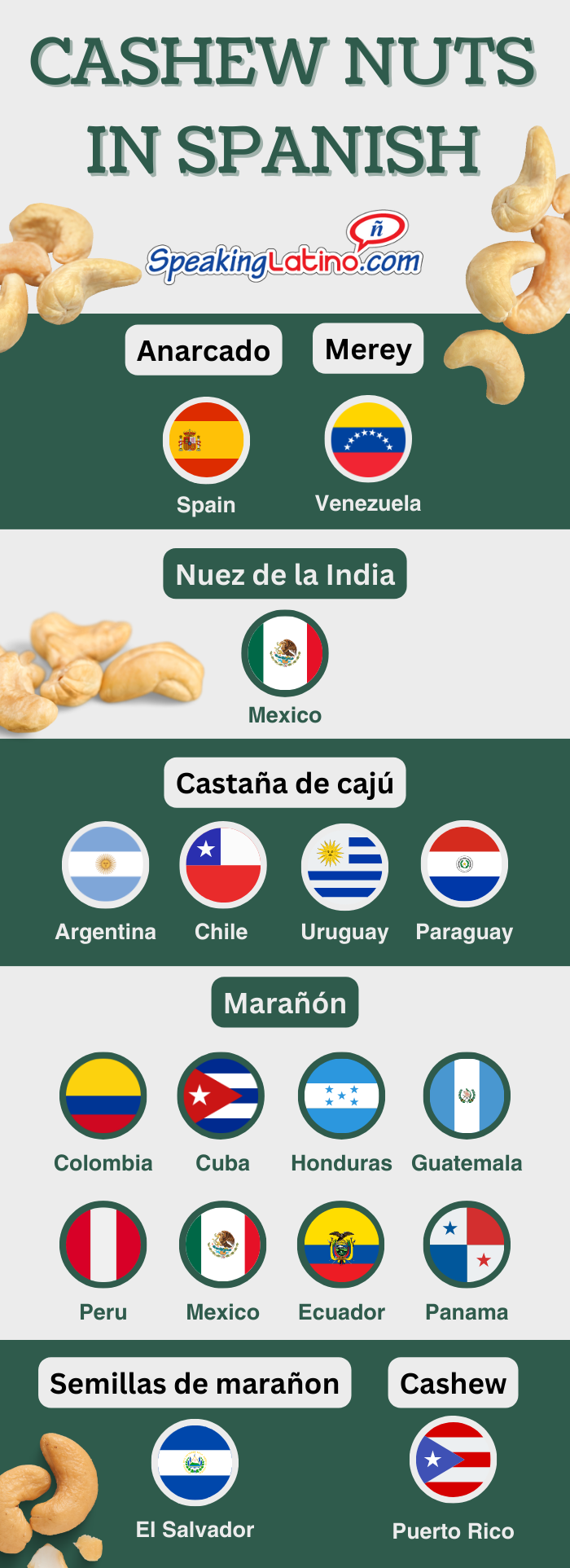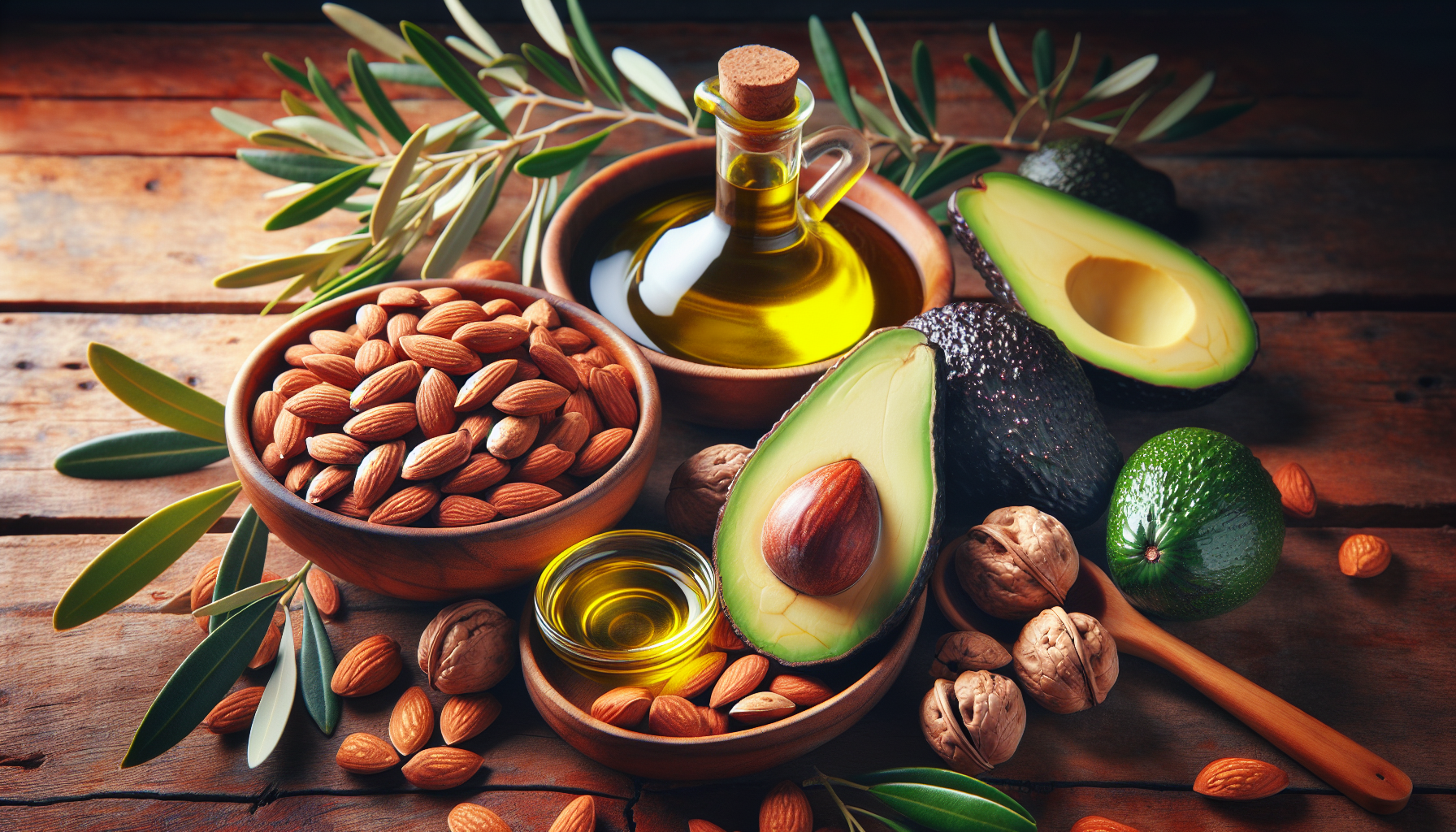What are ‘nuts’ called across Spanish-speaking cultures? From ‘nueces’ to ‘frutos secos, ‘almendras’, or the several ways to say peanuts or cashews in Spanish, this complete guide dives into the terms for different types of nuts, regional distinctions, and practical nut vocabulary in conversation.

Nut Basics
- The Spanish term ‘nueces’ generally encompasses all types of nuts, while ‘frutos secos’ most often refers to a broader category including nuts and dried fruits. ‘Tuerca’ is a term used in the mechanical context for a metal nut, highlighting the lexical diversity in Spanish, the same word in English has two different translations into Spanish.
- Specific types of nuts have their own Spanish names, such as ‘almendras’ for almonds or ‘cacahuetes/mani’ for peanuts. Nut butters are referred to as ‘crema de’ or ‘matequilla de’ followed by the specific nut name.
Understanding the Different Terms for “Nuts” in Spanish
‘In English, the term ‘nuts’ is often used as a catch-all to describe the hard-shelled edible seeds of various plants. ‘Nueces’ in Spanish broadly covers all kinds of nuts. Whether you’re munching on almonds, cashews, or walnuts, you’re essentially eating ‘nueces’. This word manifests versatility in day-to-day Spanish conversation. The phrase “Supongo que tendré que comer nueces” can be translated to “I guess I will have to eat nuts” in English. This use of “supongo” conveys uncertainty or speculation.
However, ‘nueces’ is not alone in the Spanish nut lexicon. There are other terms, each with its own connotations and usage. For instance, ‘frutos secos’ is a broader category that includes not just ‘nueces’, but also a variety of dried fruits. And then there’s ‘tuerca’, a term that refers to a mechanical nut rather than an edible one. We’ll now uncover the unique characteristics of each of these terms.
At the sametime, ‘nueces’ can adopt a more specific meaning based on the context and the country where you are. For instance, in Spain, ‘nueces’ often refers specifically to walnuts. This exemplifies the richness and flexibility of the Spanish language, where a single term can encompass a broad category or pinpoint a specific type, depending on the context.
Frutos Secos: A Broader Category
‘Frutos secos’, a category even broader than ‘nueces’, encompasses not only nuts but also a range of dried fruits (most of the time, sometimes it just means nuts!). This term is not limited to a single kind like ‘nueces’. Under the ‘frutos secos’ umbrella, you’ll find foods such as:
- figs
- apricots
- prunes
- legumes
- whole grains
- nuts
What’s fascinating is that the use of ‘nueces’ as opposed to ‘frutos secos’ can differ based on the region and the specific conversational or formal context within Spanish-speaking countries. For example, in Spain, ‘frutos secos’ is the general term used for nuts, not including dried fruits, instead of ‘nueces’. It’s interesting how regional influences can shape the use of language!
Common Types of Nuts in Spanish (plus Infographic)
With a solid grasp of the general terms for ‘nuts’ in Spanish, we can now uncover the specifics. Like a squirrel foraging for food, we’ll traverse the Spanish nut world, collecting different types of nuts and exploring their Spanish translations.

Here is a list of the most common nuts:
- Las almendras – almonds
- Las nueces, las nueces de castilla – walnuts
- Los pistachos – pistachios
- Las castañas – chestnuts, while in Perú castañas can mean Brazil nuts
- Las castañas de cajú, anacardos, merey, nuez de la india, marañones are all different words for cashews, depending on which country you are in.
- Las avellanas – hazelnuts or filberts
- Los piñones – pine nuts
- Las pecanas – pecans
- Las bellotas – acorns
- Las macadamias, nueces de macadamia – macadamia nuts
- Los cacahuetes, cacahuates or maní – peanuts
While the English names for nuts are universally recognized across the English-speaking world, the Spanish translations can vary widely across Spanish-speaking communities. Some nuts, such as pistachios, macadamias, and almonds, use the same words all around the Spanish world, while others, like peanuts and cashews can use unique words from one country or region to the next. Here is a deeper exploration of those regional differences…
Cashews: The nut with the most words
For some reason, cashew specifically is the nut with the most variations in Spanish. There are at least 7 different ways to say cashew in Spanish-speaking countries:
- castaña de cajú – Argentina, Chile, Uruguay, Paraguay
- anacardo – Spain
- merey – Venezuela
- nuez de la india – Mexico
- marañon – Colombia, Cuba, Honduras, Guatemala, Peru, Ecuador, Mexico, Panama
- semillas de marañon – El Salvador
- cashew – Puerto Rico

Peanuts: Los Cacahuetes, Cacahuates or Maní
The humble peanut is our first subject in this exploration of specific nuts. But don’t be fooled by its simplicity. In Spanish, peanuts can be referred to using different terms – ‘cacahuetes’ , cacahuates’ and ‘maní’. ‘Cacahuetes’, pronounced ‘kah-kah-weh-tes’ with a stress on the second syllable, is one of the Spanish terms for peanuts. And cacahuAte only has one letter different from cacahuEte so you can quickly slip by and miss the difference, however, native Spanish speakers will quickly recognize you’re not a local, when you replace one for the other.
However, the linguistic journey of the peanut doesn’t end there. The word ‘maní’ is an alternative term used for ‘peanuts’ in Spanish, pronounced as ‘mah-nee’ with the emphasis on the second syllable. Whether you prefer ‘cacahuetes’ or ‘maní’, the peanut remains a versatile and popular nut in Spanish-speaking countries.
Almonds: Las Almendras

The almond is our next stop on this nut-infused journey. Known as ‘almendras’ in Spanish, almonds are as versatile as they are delicious. Pronounced ‘ahl-men-drahs’ in Spanish, with the stress on the second syllable, almonds are a favorite in many Spanish-speaking countries.
Their culinary uses are as varied as their forms. For instance, a common snack in Spain is fried almonds with salt. The most exclusive almonds, known as marcona almonds, hail from Spain and are prized for their unique texture and flavor. Whether enjoyed raw, roasted, or incorporated into dishes, ‘almendras’ are a staple in Spanish cuisine.
Walnuts: Las Nueces
As our exploration continues, we come across ‘nueces’, a term specifically referring to walnuts in Spanish. Pronounced ‘nweh-ses’ in Spanish, with the stress on the first syllable, walnuts are a beloved nut in many Spanish-speaking countries.
Another term for walnuts is ‘nueces de castilla’, adding yet another layer of nuance to our understanding of ‘nueces’ in Spanish. Whether you’re enjoying them as a standalone snack or using them in a recipe, ‘nueces’ add a delightful crunch and rich flavor to any culinary creation.
Nut butters in Spanish
Moving from the crunchy realm of nuts, we enter the creamy universe of nut butters. Nut butters, ranging from peanut, almond, cashew, hazelnut and walnut are now widely available in cities throughout the Spanish-speaking world, and are a staple in many households.
For any type of nut butter in Spanish, you can say ‘Crema de’… and add the name of the nut. For example:
- ‘Crema de maní’ or ‘Crema de cacahuete’ is peanut butter
- ‘Crema de anacardo’ or ‘Crema de castaña de cajú’ is cashew butter
- ‘Crema de almendras’ is almond butter
Another term you can use is ‘Mantequilla de…’ instead of Crema de… As usual, the correct term to use will depend on the country you are in, or the people you are speaking with.
Whether spread on toast, dolloped on pancakes, or used in baking, these creamy delights add a nutty twist to any dish. Plus there’s lots of protein included!
Common ways to eat or prepare nuts in Spanish
Approaching the end of our exploration of specific nut types, let’s ponder over the different methods to eat or prepare nuts in Spanish. Nuts can be enjoyed in a multitude of ways, each preparation method offering a unique taste and texture.
You can savor them in various ways:
- Raw (‘nueces naturales’ or ‘puras’)
- Fried (‘fritas’)
- Candied (‘confitados’)
- Boiled (‘hervidos’)
- Roasted (‘asados’ or ‘horneados’)
And then there are nut butters, known as ‘en crema’ or ‘crema de…(and the nut name)’. Whether you prefer your nuts raw or roasted, simple or transformed into a creamy butter, there’s a world of possibilities to explore in the Spanish nut landscape.
Using Nut-Related Vocabulary in Context
With our newfound knowledge about nuts in Spanish, we can now put what we’ve learned into practice. Using nut-related vocabulary in various contexts not only enriches our Spanish language skills but also allows us to engage in meaningful, culturally relevant conversations while also avoiding any nut-related medical emergencies!
Typical phrases for nut allergies in Spanish
Knowing how to tell someone about your nut allergy in Spanish is crucial if you have one. This can be a life-saving skill, particularly when traveling in Spanish-speaking countries. Here are some typical phrases that can help you inform others about your nut allergy.
For instance, “Soy alérgico a nueces (o frutos secos)” means “I am allergic to nuts.” If you’re at a restaurant or buying food, you can use “¿Este plato no tiene nada de nueces, correcto?” which translates to “This plate doesn’t have any nuts, right?”
If you need to stress the severity of your allergy, you can use “Por favor, nada con nueces, soy muy alérgico”, meaning “Please, nothing with nuts, I am extremely allergic”.
How to request organic nuts

You may also find organic nuts in Spanish-speaking countries. As is common for anywhere, you will be more likely to find them in larger cities.
There are two ways to request organic nuts. The most common term is nuez orgánica used throughout Latin America. In Spain, the more common term is nuez ecológica although the term orgánico will also be understood.
Talking About Your Favorite Nuts

Discussing our favorite nuts is one of the simplest applications of our new vocabulary. Doing so allows us to express our personal tastes and dietary choices, making our conversation more relatable.
For instance, you can say “Las almendras son mis frutos secos preferidos por su versatilidad y sabor” (Almonds are my favorite nuts for their versatility and flavor). Or you might prefer macadamia nuts and say “Prefiero las nueces de macadamia por encima de cualquier otro tipo; son simplemente deliciosas” (I prefer macadamia nuts over any other kind; they are simply delicious).
Describing Nut Dishes and Recipes
Our nut-related vocabulary extends beyond expressing personal preferences, it can also describe nut dishes and recipes. This not only allows us to share our culinary adventures but also adds a flavorful dimension to our Spanish language skills.
From the almond-infused ‘turrón de Jijona’ to the refreshing ‘horchata de chufa’ made with tiger nuts (chufas), there’s no shortage of nut dishes and recipes to talk about in the Spanish-speaking world. Whether you’re describing the rich flavor of a walnut-studded brownie or the vibrant color of a pistachio-enhanced fruit salad, using nut-related vocabulary in Spanish can make your culinary descriptions come alive.
Nut-related idioms and phrases
Many nut-related terms find their way into common phrases and idioms used in Spanish. Take notice that these phrases are often specific to one or two countries and will not be understood throughout the Spanish-speaking world. Here are a few to get you started:
Estar como una nuez
The Spanish idiom ‘estar como una nuez’ offers a positive spin on the nut theme. It means to be very fit or in very good health. This expression is often used to describe someone who is surprisingly healthy despite their age or other potential health-affecting factors.
For instance, if you see an elderly person running a marathon, you might say, “¡Esa señora está como una nuez!” meaning “That lady is as fit as a fiddle!” Through such expressions, we see how nuts – symbols of health and vitality – enrich the Spanish language and serve as a sign of their cultural significance.
No tener dos dedos de frente
Our nutty journey concludes with a humorous expression – ‘no tener dos dedos de frente.’ This Spanish idiom translates informally to ‘to be as thick as two short planks,’ meaning to lack common sense or intelligence.
While it doesn’t directly reference nuts, it’s a fun way to round off our exploration of nut-related vocabulary and expressions in Spanish.
Mucho ruido, pocas nueces
In Chile the phrase mucho ruido, pocas nueces is a common way to say ‘all bark and no bite’ meaning that someone or something makes a lot of noise but doesn’t follow through.
For instance, a dog who barks and growls and jumps around a lot, but never attacks or bites anyone.
Or a person who talks about how successful they will be but then never does anything to work towards being successful.
Other common Spanish nut questions
¿Qué significa el NUT?
El Número Único de Trámite (NUT) es el número asignado a cada trámite dentro del historial migratorio de una persona extranjera, como un certificado de empleo para visitar México.
¿Cómo se escribe Nut?
La palabra “Nut” se escribe como “nuez” en español o también “fruto seco” dependiendo del país. Por ejemplo, “No me gustan los brownies con nueces (frutos secos)”.
What is the general term for nuts in Spanish?
The general term for nuts in Spanish is ‘nueces.’
What are some common types of nuts in Spanish?
In Spanish, some common types of nuts are ‘las bellotas’ (acorns), ‘las almendras’ (almonds), ‘las nueces’ (walnuts), and ‘los cacahuetes’ or ‘maní’ (peanuts).
What is the word for a mechanical nut (to go with a bolt)?

Just as we seemed to have covered the diversity of ‘nuts’ in Spanish, we encounter ‘tuerca’. In the mechanical domain, ‘tuerca’ refers to a small metal piece with a threaded hole, designed to secure a bolt. This is a stark departure from the edible nut ‘nueces.’ Yet, it serves as a testament to the versatility of the Spanish language, where a single word in English – ‘nut’ – can refer to a culinary delight or a fundamental mechanical component.